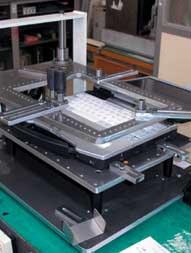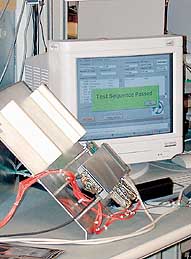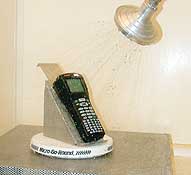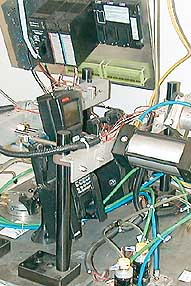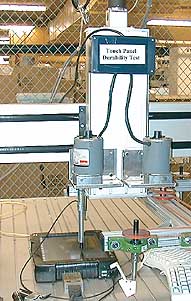|
Technology Primers
Description and analysis of enabling technologies
(by RuggedPCReview staff and contributors)
While product reviews and specs are important, understanding underlying systems and technologies is equally important. This is why RuggedPCReview.com explains the major technologies, platforms, and developments in detailed primers and overviews.
-
What's your laptop or tablet's gas mileage? (2024)
How long does a charge of the battery in your phone, tablet or laptop last? How long is it supposed to last? If the tech specs do include battery life, can you trust that number? How was it measured? Can you rely on it? How much does battery life matter? Or is it just something that should last long enough?
-
Cooling Methods of Rugged Mobile Devices (2023)
When the going gets tough enough to require a certifiably rugged mobile tablet or laptop, field workers rely on that device to meet performance and connectivity expectations while keeping cool under the assails of heat, dirt and dust, potentially explosive gasses, and the blazing sun.
- Intel Alder Lake (2022)
It isn't easy to keep up with Intel's prolific introduction of ever more processors, processor types and processor generations. Or to figure out what truly matters and what's incremental and more marketing than compelling advancement. That's unfortunate as Intel, from time to time, does introduce milestone products and technologies. With their 12th generation of Core processors the company is introducing such a milestone, but it isn't quite clear just yet what its impact will be.
- Ingress Protection (2021)
What sets rugged handheld computers and tablets apart from standard consumer products is their ability to take the kind of punishment that comes with using a device on the job and in the field where conditions can be harsh. As a result, the specification sheets of virtually all rugged devices include the results of certain ruggedness tests. How much of that data is supplied varies from manufacturer to manufacturer. It can be very comprehensive or just touch upon the basics.
- Thunderbolt 4 (2021)
Thunderbolt started as a joint effort between Intel and Apple, combining the PCI Express and DisplayPort signals. The latest version, Thunderbolt 4, uses the USB Type-C connector, supports charging upstream and downstream, USB 4 with up to 40 Gbit/s (5 GB/s) throughput as well as dual 4K displays. Is it the crowning "one wire" connectivity and charging answer to the increasingly fragmented USB landscape?
- Growing Interest for Linux Tablets and Panels (2021)
There has been an uptick in searches and inquiries for Tablet PCs and Panel PCs with Linux Operating Systems. The bulk of those searches are for Linux Tablet PCs. With industrial Panel PCs that handle Linux natively and rugged Tablet PCs that can utilize Linux as a custom ODM or OEM project, Estone Technology explored potential causes for this uptick in search. The product lines for Linux panel PC and a tablet with Linux have distinctly different uses. The feature explores some of the benefits of Linux by the type of product to identify the cause for the trend.
- Intel generations (2021)
It seems like only yesterday that Intel introduced the high-end Core processor brand, and now it's a decade later and we're already seeing the 11th generation. While initially it wasn't very difficult to keep the generations apart and determine when and what to buy, it's become quite confusing as of late. This feature examines the various areas, aspects and issues regarding the processor family that drives the vast majority of mobile Windows computers today.
- Consumer Smartphones vs Rugged Handhelds (2021)
What is the difference between consumer smartphones and handheld computers that have specifically been designed to be rugged and capable of withstanding a variety of handling and environmental challenges? That is a question that's been asked ever since the advent of modern smartphones, which is generally since the Apple iPhone was introduced in 2007.
- Thoughts about Computer Benchmark Testing (2020)
Computers don't have a single horsepower rating, so how do you best determine their real world performance? Unlike vehicles whose specifications include a horsepower rating, computers don't have a single number that indicates how powerful they are. True, horsepower (what an antiquated term that is) isn't really all that relevant, because that number alone doesn't tell the whole story.
- How the rugged PC "drop spec" just became different (2019)
You wouldn't know it from looking at almost all of the published ruggedness testing results, but the good old DOD MIL-STD-810G was replaced by the MIL-STD-810H in January 2019. And if you thought the old MIL-STD-810G was massive in size, the new one is bigger yet. While the old MIL-STD-810G document was 804 pages, the new one has 1,089. That's 285 extra pages of testing procedures. And a lot has changed. This article looks at the latest changes to the "drop spec."
- The Drone in Your Future (2019)
Drones have made tremendous progress and will likely become part of many jobs. So let's see where drones are today and where they may be headed. Yes, you can pick up a cheap drone at every Walmart or similar store for very little money. Those willing to spend more money will find a rapidly increasing degree of sophistication. The sooner you start acquainting yourself with drone technology, the better off you are.
- The uneven performance of cameras in rugged handhelds and tablets (2019)
Few would have foreseen that smartphones would almost completely replace dedicated cameras within less than a decade. Fewer yet the stunning advances in quality, features, and overall technology in smartphone cameras. Unfortunately, cameras integrated into rugged and vertical market devices have consistently trailed what is available in consumer phones by a large margin.
- Best practices for rugged tablets in the military (2018)
The durability of rugged tablets is beyond contention -- these devices can endure falls of several feet, water exposure and glaring sunlight while delivering computing consistency in even harsh military settings. But the greater value of their deployment in the armed forces is their influence in realizing organizational objectives at the tactical, strategic and operational levels where they enable a wide range of real-time intelligence.
- IR 2.0 (2018)
The IR sensor is a crucial component in many everyday products, ranging from medical equipment to mobile phones. But the technology is 50 years old and in serious need of an upgrade. The next generation IR sensor 2.0 for IoT will be much thinner than old sensors and cheaper to manufacture.
- Mass storage issues (2018)
From rotating hard disks to solid state media to eliminating remaining bottlenecks — will the emergence of PCIe-based SSDs redefine mobile computing performance? RuggedPCReview.com examined an early example of a rugged tablet with PCIe-based solid state disk, and found massive performance improvements.
- Electronics potting (2017)
Electronics potting — where electronic components are "potted" in suitable enclosures and with suitable compounds that not only protect against shock and vibration, but also against formation of moisture and exposure to corrosive agents — is a simple, cost-effective way to increase the reliability and longevity of electronics components and systems.
- Explosion Protection (2016)
With the ongoing quest for cost-effective productivity enhancing measures, there's an increase in demand for intrinsically safe mobile computing gear, the safe operation of which requires far more than mere certification documentation. Improper deployment can have life-threatening consequences, and ultimately the responsibility for proper use is with the user.
- HazLoc Primer (2016)
Despite of its crucial importance to the safety of equipment and personnel, the hazardous location (HazLoc) market is poorly understood outside the small circle of people who are directly involved with it. Even insiders often struggle with describing what "HazLoc" really means, what "intrinsic safety" is, and what all the various classifications pertaining to hazardous location safety mean. We present answers to the most important HazLoc questions
- Intel's Kaby Lake (2016)
In August 2016, Intel officially introduced the first few of its 7th generation Core processors, codenamed "Kaby Lake." That comes at a time where the news about PCs generally isn't very good, where Microsoft has a very hard time convincing users to switch to Windows 10, and where it's becoming increasingly more difficult for vertical market hardware manufacturers to keep up with Intel's rapid-fire release of new generations of high-end processors.
- More than the naked eye can see (2016)
Caterpillar introduced the Cat S60, which the company calls "the world's first thermal imaging smartphone." The Snapdragon 617 octa-core powered Android Marshmallow phone has a bright 540 nits 4.7-inch procap display that can handle wetness and gloves. Ruggedness specs are quite impressive with a 6-foot drop, and what appears to be IP68 sealing. The Cat S60 is said to be waterproof down to 17 feet for an hour, and its 13mp documentation camera can supposedly be used underwater. And it has a built-in FLIR Lepton module. So you get thermal imaging built right into your rugged smartphone.
- An assessment of the Apple Pencil (2015)
Steve Jobs was adamantly opposed to pens, but 5-1/2 years after the iPad was first introduced, the Apple Pencil became available for the big iPad Pro. It's expensive (US$99), but it may well change what users expect from a tablet. How well does the Apple Pencil work, and has Apple learned from history?
- Impact of the Apple iPad Pro (2015)
Will the Apple iPad Pro herald an era of "pro" use of tablets? A look by RuggedPCReview's Editor-in-Chief Conrad Blickenstorfer at the 12.9-inch iPad Pro, what the extra size means for productivity, split-screen use, what to make of the Apple Pencil, and what impact the new big iPad might have on the future of tablets.
- What led to the Universal Stylus Initiative (2015)
Capacitive multi-touch has taken the world by storm, but the technology is more suited for consumption than creation. For that, having an active pen is desirable for many reasons, but active pen technology is proprietary, adding to costs and limiting markets. The Universal Stylus Initiative seeks to change that.
- Replacing the Atom N2600 (2015)
Intel's early Atom processors didn't live up to all expectations, especially in the performance department. It wasn't until the Atom N2600 that the platform came into its own, and the chip was used in numerous products. But time moves on, and the venerable N2600 is being replaced by newer, faster chips.
- Rugged Computers Are More Than Just 'Hard Shells' (2014)
Even professional users of rugged laptops, tablets and smartphones, are sometimes unsure of what defines a "rugged computer" and how the various tests to validate ruggedness are carried out. A truly rugged computer is so much more than just a normal computer wrapped in a tough outer case, as Handheld's CEO Jerker Hellström explains in this article.
- What Really Makes A Mobile Device Screen Readable Outdoors? (2013)
Understanding the underlying elements of outdoor readable screens can help you to select the right mobile device for your operating conditions, by Patrick Seidensticker, Dell
- Does your Pentium have an Atom engine? (2013)
There was a time, when buying a computer, the sole decision you needed to make was whether to use the Intel 386/33 or save a few bucks and get the slightly slower 386/25. Today, if you use Intel's ARK app that lists every product available from Intel, there are almost 2,000 different processors listed, by Conrad Blickenstorfer
- So you want a rugged handheld? (2013)
Contemplations on the state of rugged handheld computers in 2013, including a look at operating systems, user interfaces, ruggedness, sealing, drop specs, operating temperature, processors, displays, storage, expansion, etc., by Conrad H. Blickenstorfer
- State of Outdoor-Viewable Displays Late 2013
One of the big differentiating factors in ruggedized mobile computers is how well the display is suited for work outdoors in bright daylight and in direct sunlight. Here's a look at available technologies and concepts, and how well it all works in practice, by Conrad Blickenstorfer
- How to succeed with mobile solutions (2013)
Mobile solutions have a huge potential to drastically increase the efficiency of field workers and save big money for companies in a range of industries. However, the implementation of mobile solutions is filled with pitfalls, by Mikael Nilebacke
- The trend towards 'ruggedish' computers and smartphones (2013)
'Ruggedish' smartphones is a global trend--and traditional rugged computer makers are best equipped to supply truly rugged smartphones and tablets, by Jerker Hellström.
- Optimizing the legacy Windows interface for touch and tablets (2013)
Windows 7 (and the desktop in Windows 8/8.1) wasn't designed for touch. Here's a primer on how to optimize the interface.
- Rugged notebooks: challenges and opportunities (2013)
A look at ruggedness definitions, the types of products available today, and the future outlook.
- Security via Common Access Card (2013)
A look at how Xplore Technologies addressed Homeland Security Presidential Directive 12 (HSPD-12) via CAC.
- Not your father's Celeron (2013)
How Intel quietly morphed the lowly Celeron into a competent, lower cost member of its Core families.
- Can your computer handle thermal stress? (2012)
How thermal management technologies affect computing performance in extreme temperature environments.
- Should you require FIPS 140-2 validation for Wi-Fi client devices? (2012)
A Laird Technologies White Paper.
- Who will make rugged tablets? (2012)
Rugged Tablet PC company executives answer RuggedPCReview's questions about opportunities in the rugged and semi-rugged tablet market as a result of the iPad's popularity.
- Clover Systems SunBook (2011)
A look at the Pixel Qi display technology, incorporated into a Samsung netbook. By Conrad Blickenstorfer
- Still/video imaging in mobile devices (2011)
Conversation with Ambarella's Chris Day about the state of still/video imaging in mobile computing devices. By Conrad Blickenstorfer
- Android Contemplations (2010)
Thoughts about the use of the emerging Android OS platform in tablets. By Conrad Blickenstorfer
- Intel vPro technology (2010)
What is Intel's vPro and how can you use it. By Conrad Blickenstorfer
- Discrete graphics (2010)
What are discrete graphics, and why would you need them? By Conrad Blickenstorfer
- Intel "Moorestown" Z6xx Atom platform (2010)
A look at Intel's Atom initiative and the "Moorestown" platform, Intel's shot at a new generation of tablet/smartphone processors. By Conrad Blickenstorfer
- Intel 2010 Core i3/i5/i7 (2010)
A look at Intel's new 2010 Core i3/i5/i7 processors and how they will affect rugged computing. By Conrad Blickenstorfer
- Intel Atom N450, D410 and D510 (2009)
A description and discussion of the second generation of Intel Atom processors, introduced in December of 2009. By Conrad Blickenstorfer
- Gorilla Glass (2009)
A look at Corning's chemically strengthened Gorilla Glass that promises better protection at less weight (and fewer fingerprints!). By Conrad Blickenstorfer
- UMPC update at the end of 2007
Microsoft introduced the UMPC with much fanfare. Where is it at the end of 2007? By Geoff Walker
- Notebooks with Outdoor-Readable Screens (2007)
A comprehensive, technical look at the state-of-the-art in outdoor-readable display technologies and how major companies use it. By Geoff Walker
-
The Ultimate Outdoor-Readable Touch-Screen Display (2007)
Examination, discussion and assessment of the GD-Itronix DynaVue outdoor viewable display technology. By Geoff Walker
-
Inductive Pen Sensing vs. Resistive Input Technology (2006)
A discussion of teh technologies, design considerations and outlook of digitizing technologies. By Ian Scholey
- UMPC Update (2006)
An analysis of what happened after Microsoft's big UMPC announcement in 2006. By Geoff Walker
-
What exactly does "rugged" mean and how is it measured?
An overview of criteria to be considered when determining ruggedness requirements. By Conrad H. Blickenstorfer
-
A Guide to Understanding and Interpreting Rugged Computer Specs
Manufacturers often list various tests their products passed. What do all those standards and specs mean? By Tim Crews
-
Wide-Angle LCDs and the Tablet PC - A discussion of wide-angle display technologies (2004)
Wide viewing angle displays revolutionized screen technology. This overlook desctibes the technology and who uses it. By Geoff Walker
-
Rugged computing terminology and standards
A description of some of the well known and lesser known ruggedness specifications. By Conrad H. Blickenstorfer
- Special Report: Webpads
Yes, webpads and tablets are nothing new. In 2002 we asked whether they are the next big thing, or just a fad. By Geoff Walker
|


















